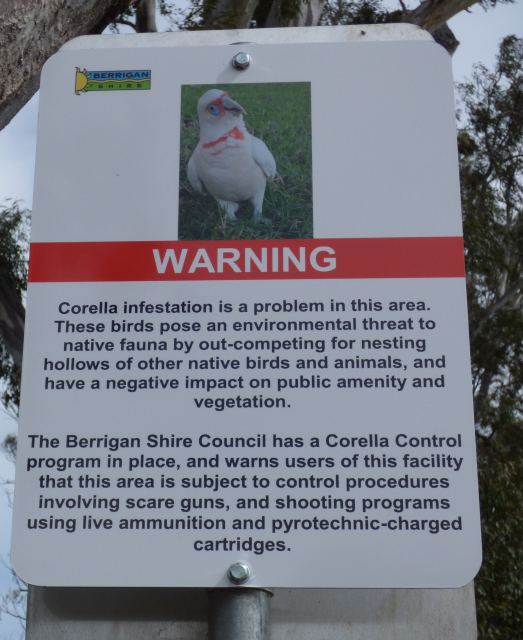 |
canberrabirds
|
 |
canberrabirds
|
| To: | Geoffrey Dabb <> |
|---|---|
| Subject: | A Visit to Victoria (6) |
| From: | Martin Butterfield <> |
| Date: | Mon, 29 Sep 2014 05:16:24 +1000 |
|
WRT Long-billed Corellas Geoffrey mentioned "...there is a gap in the distribution between about Deniliquin and Canberra ...". We visited Finley, about 60km East of Deniliquin late last week and spotted 5 Long-bills in the showground. When we dropped a tad (~20km) down to the mirror we found that the species wasn't welcome:  It is interesting in that there seems to be uncertainty whether the Burghers of Berrigan regard the Corella as a native bird or not. I'm not sure what is meant by a loss of public amenity but would have thought the use of scare guns and live ammunition would constitute a far greater loss of this attribute of the river bank (and the scare guns would also drive off all native fauna not just the Corellas). Martin Martin Butterfield
On 23 September 2014 13:57, Geoffrey Dabb <> wrote:
|
| <Prev in Thread] | Current Thread | [Next in Thread> |
|---|---|---|
| ||
| Previous by Date: | Brown Thornbills, djflotek flotek |
|---|---|
| Next by Date: | A Visit to Victoria (6), Martin Butterfield |
| Previous by Thread: | A Visit to Victoria (6), Geoffrey Dabb |
| Next by Thread: | A Visit to Victoria (6), Martin Butterfield |
| Indexes: | [Date] [Thread] [Top] [All Lists] |
The University of NSW School of Computer and Engineering takes no responsibility for the contents of this archive. It is purely a compilation of material sent by many people to the Canberra Ornithologists Group mailing list. It has not been checked for accuracy nor its content verified in any way. If you wish to get material removed from the archive or have other queries about the list contact David McDonald, list manager, phone (02) 6231 8904 or email . If you can not contact David McDonald e-mail Andrew Taylor at this address: andrewt@cse.unsw.EDU.AU